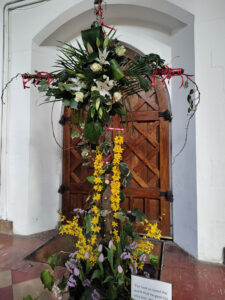Readings
Acts 2:14a, 22-32; Psalm 16; 1 Peter 1:3-9; John 20:19-31
Sermon by Reader Christopher Ward
May I speak in the name of Almighty God, Father, Son and Holy Spirit. Amen.
One of the words that comes into my mind when I look back at the spiritual events of the last couple of weeks, and indeed further back, is ‘transformation’. A fortnight ago, on Palm Sunday, we recalled Jesus’ triumphal entry into Jerusalem. By Good Friday, we were contemplating a broken body, hanging lifeless from a Cross. And last Sunday, Easter Sunday, we joyfully celebrated Jesus’ resurrection. That’s quite a lot of transformations!
But there are also transformations within this church, and one that I first noticed last Sunday has given me a lot of cause for thought. It’s still here, and it is within the beautiful floral arrangement by the font that was created by Wendy and Kim. So what is so special about it?
The first thing is that, at its heart, is a cross. I cannot recall when I last saw a decorated cross, let alone one as lavishly decorated as this one. Crosses are normally bare, sometimes with a figure of Jesus hanging on them. The opening lines of that familiar Good Friday hymn, The Old Rugged Cross, put the traditional image of the Cross so eloquently, “on a hill far away stood an old rugged cross, the emblem of suffering and shame”. We don’t normally adorn emblems of suffering and shame.
The second thing is the provenance of the cross, because it is not just any old cross. It is in fact the cross that, throughout Lent, stood in the chancel, where our paschal candle now stands, the light of Christ replacing the emblem of suffering and shame – again, quite a transformation!
But that crude, simple, cross was itself the result of a transformation, because it was made from the wood of the Christmas tree that, from Advent to Candlemas, stood close to where that decoration now stands. So that cross, which started its life in our church as a thing of beauty, is once again restored to that state. For me, that provides a powerful echo of the journey from that helpless baby in the manger, through death on the Cross, to the Risen Lord.
I often think that, with our focus on events Sunday by Sunday, we don’t always have the opportunity to reflect as much as we might on the broad sweep of events. Last Sunday, we joyfully celebrated the resurrection of our Lord. This Sunday, as we begin to travel forward in the Easter season, is perhaps an opportune moment to reflect on the journey along which the wood of that cross has been our constant companion. It was with us in Advent, when we awaited the birth of Christ and it remained with us as we celebrated his revelation to the world in the Epiphany; it was with us in Lent, as we journeyed towards the Crucifixion; and it is with us now, as we celebrate the risen Christ.
And it also reminds us of what lies at the heart of our spiritual journey of the last few months. The words on the inscription at the base of the arrangement, which are taken from John’s Gospel and were also at the base of the unadorned cross in the chancel, tell us that God so loved the world that he gave his only son, so that everyone who has faith in him may not perish but have eternal life[1]. That is a transformation of truly cosmic significance! In other words, that arrangement at the back of the church encapsulates for us the overarching power of God’s love for all humanity.
Our readings today also echo the theme of transformation. The passage we heard from Acts is part of Peter’s address to the crowd at Pentecost. A more confident, eloquent and powerful assertion of Jesus as the Messiah is difficult to imagine. The Peter of whom Jesus said, “Get thee behind me, Satan”[2] is long gone; the frightened figure cowering in the courtyard of the Temple following Jesus’ arrest and who three times denied that he knew Jesus is also long gone. Peter is transformed.
And in our Gospel reading, we heard the story of Thomas, and his reaction to the news that other disciples had actually seen the risen Lord, a week before, in the evening following their discovery of the empty tomb. But Thomas was I think a rationalist. Jesus had been very publicly crucified and everyone knew that this had only one outcome: certain death. The idea that Jesus had appeared as if from nowhere within a locked room was also completely illogical. But I think it noteworthy that Thomas did not simply reject this apparently crazy idea, he simply wanted hard evidence before he could himself actually believe. As we heard in our Gospel reading, Jesus once again appeared to the disciples in that room a week later, when Thomas was present, and Thomas received the proof that he craved. Thomas was transformed, exclaiming, “My Lord and my God”.
But the story does not end there. By Jesus’ death and resurrection, we too can be transformed, as promised by the message under the decorated cross by the font. In his Gospel John writes, as we heard today, that the particular signs recorded in his Gospel are but a selection of those which Jesus performed in the presence of his disciples. Those which are included in his Gospel, John tells us, were included for a very specific reason: that we may come to believe that Jesus is the Messiah, the Son of God, and that through believing may have life in his name.
Let us pray for the faith to sustain such a wonderful transformation!
Amen
[1] John 3:16
[1] Matthew 16:23; Mark 8:33; Luke 4:8.


Recent Comments